Natural killer (NK) cells are immune cells that have been genetically engineered to express chimeric antigen receptors and are capable of killing target cells (CARs). For solid tumors and hematological malignancies, CAR-NK cell treatment is a novel kind of cancer immunotherapy.
CAR-NK cells work by killing cancer cells in a CAR-dependent way. CAR-NK cells and unmodified NK cells provide safety benefits over regular CAR-T cells.
Since CAR-NK cells have a short lifespan, the possibility of on-target/off-tumor damage to normal cells is considerably reduced. CAR-NK cells can also be created from several sources, such as NK92 cells, umbilical cord blood (UCB), peripheral blood mononuclear cells (PBMCs), and induced pluripotent stem cells (iPSCs), because of the lower risk of all reactivity and Graft versus host disease (GvHD).
Solid tumor CAR-NK targets
NKG2D and NKG2D ligands
By connecting with its tumor-associated overexpression ligands, such as MICA, MICB, and ULBPs, NKG2D, an activating NK cell receptor can modulate the cytotoxic capability of NK cells against cancer (ULBP1, ULBP2, ULBP3, ULBP4, ULBP5, ULBP6). The NKG2D–NKG2D ligand pathway is a potential therapeutic target and a good starting point for NK-focused CAR creation.
High activity NKG2D and NKG2D ligands proteins from various species
Binding activity validated by ELISA assay
Human NKG2D (Cat#: 10575-H01S)
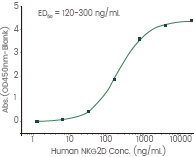
Bind with Human MICA (Cat#: 12302-H08H). Image Credit: Sino Biological Inc.
Ligands bind with NKG2D (Cat#: 10575-H07B)
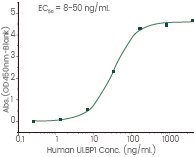
Human ULBP1 (Cat#: 10679-H03H). Image Credit: Sino Biological Inc.
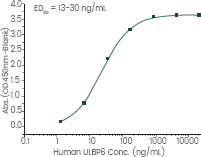
Human ULBP6 (Cat#: 15759-H02H). Image Credit: Sino Biological Inc.
A comprehensive panel of antibodies targeting NKG2D, MICA, MICB, ULBP1, and ULBP2 for various applications (FCM, ELISA, WB, IHC, IF, etc.)
Anti-MICA antibody (Cat#: 12302-MM04)
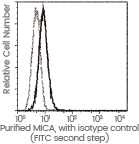
Flow Cytometric Analysis of Human MICA Expression on HeLa Cells. Image Credit: Sino Biological Inc.
Anti-MICB antibody (Cat#: 10759-MM12)
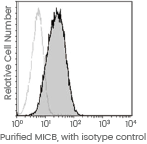
Flow Cytometric Analysis of Anti-MICB on MCF-7 Cells. Image Credit: Sino Biological Inc.
Anti-ULBP2 antibody, Rabbit mAb (Cat#: 12143-R022)
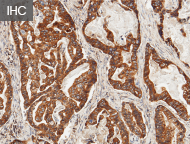
Immunochemical Staining of Human ULBP2 in Human Gastric cancer Cells. Image Credit: Sino Biological Inc.
PD-L1
In numerous cancer types, PD-L1 is increased in the tumor microenvironment and immunosuppressive cells. In vitro PD-L1 targeted CAR-NK cells demonstrated specific anti-tumor activities against 15 tumor cell lines, and in vivo, they showed substantial anti-tumor effects against triple-negative breast, bladder, and lung cancers.
High activity recombinant PD-L1
Human PD-L1 protein (Cat#: 10084-H02H)
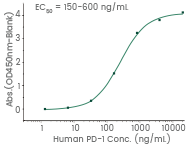
Immobilized human PD-1 (Cat#: 10377-H08H) can bind human PD-L1 by ELISA. Image Credit: Sino Biological Inc.
Mouse PD-L1 protein (Cat#: 50010-M41H-B)
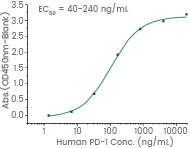
Immobilized Human PD-1 His & hFc (Cat#: 10377-H03H) at Mouse PD-L1 (Biotinylated). Image Credit: Sino Biological Inc.
Rat PD-L1 protein (Cat#: 80450-R08H)
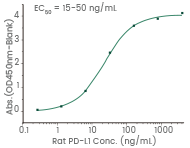
Immobilized Rat PD-L1 His can bind Rat PD-1 (Cat#: 80448-R02H). Image Credit: Sino Biological Inc.
HER2/ERBB2
On carcinomas such as breast, esophageal, gastric, ovarian, and endometrial malignancies, HER2/ERBB2 is typically overexpressed. HER2 is expressed in 80% of glioblastomas and is linked to a poor prognosis. The use of HER2-targeted CAR constructs has been extensively researched. HER2-specific NK cells are a potential tumor adoptive immunotherapy approach.
Human HER2 protein (Cat#: 10004-H02H)
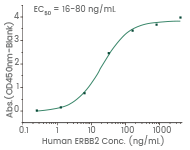
Immobilized ERBB2 Protein can bind to Anti-ERBB2 Antibody. Image Credit: Sino Biological Inc.